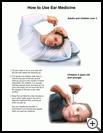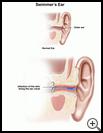
Ear: Swimmer's (Otitis Externa)
What is swimmer's ear?
Swimmer's ear is an infection of the skin lining the ear canal. This problem is most common among swimmers or children that spend a lot of time in water. If your child has swimmer's ear, he or she may have the following symptoms:
- Itchy and painful ear canals
- Pain when the ear is moved up and down
- Pain when the tab overlying the ear canal is pushed in
- Ear feels plugged up
- Slight amount of clear discharge at first (without treatment, the discharge can become yellowish).
What is the cause?
Swimmer's ear occurs when your child's ears have been in the water for long periods of time. When water gets trapped in the ear canal the lining becomes damp, swollen, and prone to infection.
Children are more likely to get swimmer's ear from swimming in lake water, compared to swimming pools or the sea. During the hottest weeks of the summer, some lakes have high levels of bacteria. Narrow ear canals also increase the risk of swimmer's ear. Cotton swabs also contribute to the problem by causing wax buildup which traps water behind it.
Suspect a middle ear infection instead, if your child also has a cold, a fever, and no increased pain with pushing on the ear tab.
How long does it last?
With treatment, symptoms should be better in 3 days and cleared up in 7 days.
How can I take care of my child?
- Antibiotic-steroid eardrops for severe swimmer's ear. (These require a prescription.)
Your child needs the eardrops prescribed by your healthcare provider.
Run 5 eardrops down the side of the ear canal's opening so that air isn't trapped under the drops. Do this 3 times a day. Move the earlobe back and forth to help the eardrops pass down. Continue using the eardrops until all the symptoms are cleared up for 48 hours.
- White vinegar eardrops.
For mild swimmer's ear, use half-strength white vinegar eardrops. Fill the ear canal with white vinegar diluted with an equal amount of water. After 10 minutes, remove it by turning the head to the side. Do this twice a day until the ear canal gets back to normal.
- Pain relief.
Use acetaminophen (Tylenol) or ibuprofen (Advil) for pain relief as needed.
- Swimming
Generally, your child should not swim until the symptoms are gone. If he is on a swim team, he may continue but should use the eardrops as a rinse after each swimming session. Continued swimming may cause a slower recovery but won't cause any serious problems.
How can I help prevent swimmer's ear?
First, limit how many hours a day your child spends in the water. The key to prevention is keeping the ear canals dry when your child is not swimming. After swimming, get all water out of the ear canals by turning the head to the side and pulling the earlobe in different directions to help the water run out. Dry the opening to the ear canal carefully. If recurrences are a big problem, rinse your child's ear canals with rubbing alcohol each time he finishes swimming or bathing to help it dry and kill germs. Another helpful home remedy is a solution of half rubbing alcohol and half white vinegar. The vinegar restores the normal acid balance to the ear canal.
Ask your healthcare provider if your child should use ear plugs or a swimming cap.
Common mistakes
- Do not put cotton swabs in ear canals. They increase earwax buildup. The earwax then traps water behind it and increases the risk of swimmer's ear.
- Rubbing alcohol is helpful for preventing swimmer's ear but not for treating it because it stings an infected ear too much.
When should I call my child's healthcare provider?
Call IMMEDIATELY if:
- The ear pain becomes severe.
- Your child starts acting very sick.
Call during office hours if:
- The ear symptoms are not cleared up in 7 days.
- You have other concerns or questions.
Last modified: 2012-05-15
Last reviewed: 2017-06-05


